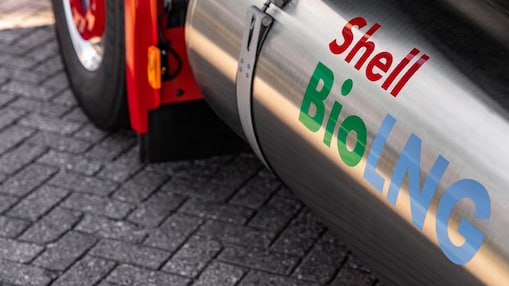Shell LNG and Shell BioLNG
Discover the benefits for your fleet.
With higher energy density than conventional diesel, these fuels are ideal for fleets covering both short and long distances.

Shell LNG and Shell BioLNG are cooled at cryogenic temperatures, reducing volume by 600 times compared to gaseous form and offering a higher energy density than conventional diesel.
Shell LNG
Cleaner and quieter, with performance comparable to diesel-fuelled heavy-duty vehicles.
Cleaner burning
In Europe, Shell LNG can help to emit less life cycle CO2e1 emissions of heavy-duty vehicle operation by up to 18% compared to B7 diesel2, depending on engine type. LNG is less polluting than diesel, producing fewer air pollutants such as NOX, SOX and PM.
Quieter engines
Perceived engine noise reduction by up to 50% in noise loudness as compared to heavy-duty diesel engines. This can contribute to improved driver well-being and fleet utilisation in noise abatement zones3.
Performance
Enjoy the benefits of LNG performance. Shell LNG provides similar driving range, engine power and performance to that of equivalent conventional heavy-duty diesel-fuelled vehicles4.
Infrastructure
Fill up without fuss. Our LNG network features more than 65 Shell-branded sites across seven countries in Europe plus over 100 partners’ 7 locations currently accepting Shell Card.
Shell BioLNG
Go even further with Shell BioLNG. Shell BioLNG is a drop-in fuel made from biofeedstocks5 leading to less CO2e1 emissions on a lifecycle basis compared to LNG6.

How is Shell BioLNG produced?
Shell BioLNG (liquefied biomethane) is derived from renewable resources such as manure or organic waste, which means it has a lower carbon intensity than LNG and contributes to the circular economy.
Bio-LNG production can work in a similar way to the composting process, since feedstocks such as organic waste can be anaerobically digested to form biogas – a mix of biomethane, carbon dioxide, water and other trace gases. After removing these by-products, the remaining biomethane can be liquified to create bio-LNG.
Explore the benefits helping to drive bio-LNG’s growing role in heavy-duty road transport’s energy transition.
No retrofitting required
Because bio-LNG’s chemical properties are practically identical to those of liquified natural gas (LNG), the switch from LNG to bio-LNG doesn’t require a change in infrastructure or equipment7.
Same trusted network
Just as no modifications are needed to your LNG vehicles to benefit from Shell BioLNG, our stations do not need to be converted either. Our network, the largest in Europe, remains available and covers the most important long-distance routes.
Greater potential in future
We are making significant investments in bio-LNG, underlining our commitment to sustainable solutions. To increase production and supply of Shell BioLNG to our network, we have acquired the largest producer of renewable natural gas (RNG) in Europe – Nature Energy – with its portfolio of 14 operating plants and associated feedstock supply and infrastructure, pipeline of growth projects, and in-house expertise in innovative RNG plant technology.
In 2024, an LNG liquefaction plant was opened at the Shell Energy and Chemicals Park in Rheinland, Germany, with a yearly production capacity of up to 100,000 tonnes of bio-LNG.
We work across the bio-LNG value chain with collaborators to off Shell BioLNG to dedicated customers in the Netherlands, Germany and Czech Republic.
Find your nearest Shell LNG and Shell BioLNG location

Site locator
We work across the bio-LNG value chain with collaborators to off Shell BioLNG to dedicated customers in the Netherlands, Germany and Czech Republic.


